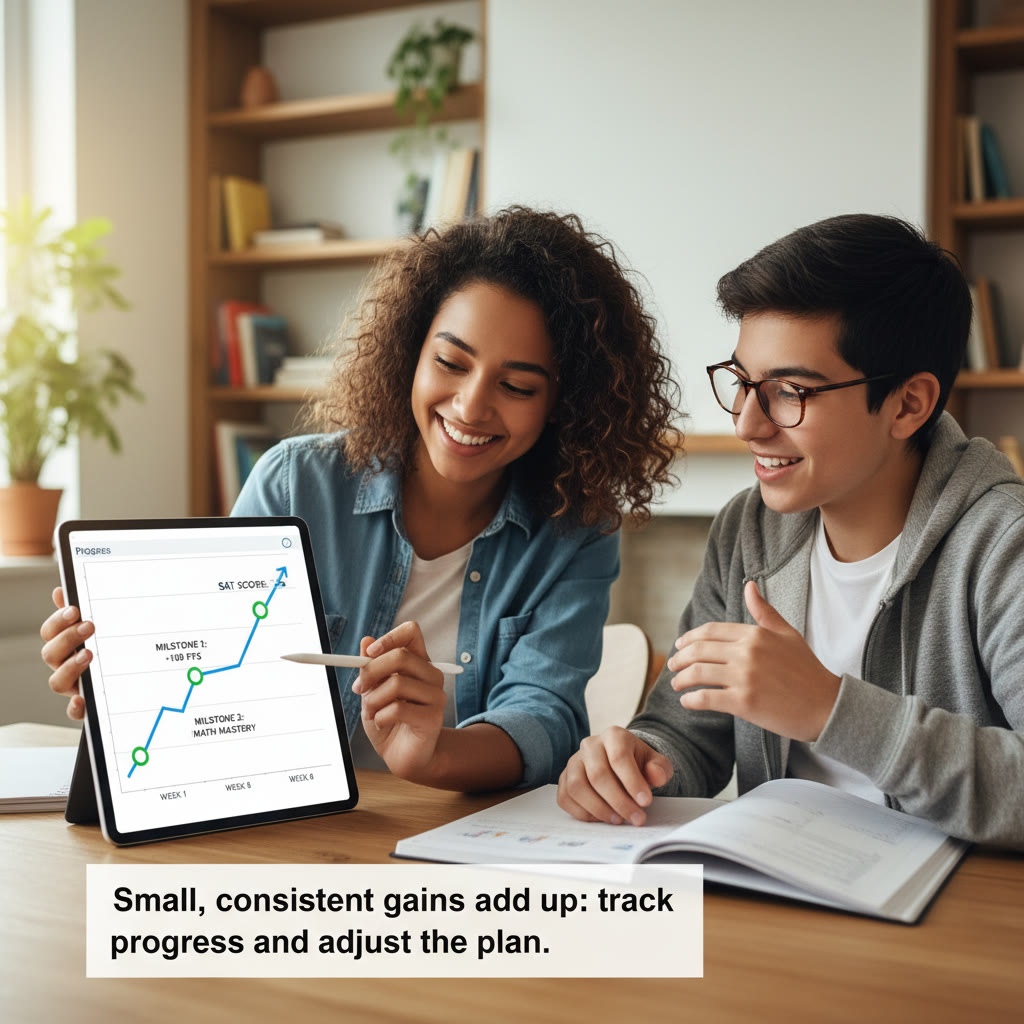Welcome to the Digital Era: Why Your Prep Needs a Refresh
If you opened this because you’re preparing for the SAT, take a breath—you’re in the right place. The SAT has already shifted into a digital format, and that change isn’t just cosmetic. It affects pacing, navigation, and how the test responds to your answers. The good news: adapting your prep style isn’t a matter of learning new math or grammar rules. It’s about shifting habits, tools, and strategy.
Think of it this way: the skills you already have are still valuable, but they need new packaging. We’ll walk through what changed and, more importantly, how to adapt. I’ll give you practical drills, a sample study plan, a comparison table, and real test-day tips. Along the way you’ll read about how Sparkl’s personalized tutoring—1-on-1 guidance, tailored study plans, expert tutors supported by AI-driven insights—can fit naturally into your preparation if you want extra structure or targeted feedback.
What Actually Changed with the Digital SAT?
Quick, accurate facts so you know what you’re preparing for:
- The exam moved from paper to a digital platform. It’s delivered on approved devices or testing software (schools and testing centers provide details).
- The test is section-level adaptive: the difficulty of later modules adjusts based on your earlier performance.
- It’s shorter and more focused in format: passages are often shorter, and many questions are more discrete and skill-specific.
- Calculators are allowed for math sections, and digital tools (built-in calculator, highlighting, flagging) are available.
- The scoring scale remains the familiar 400–1600, so your target scores are unchanged.
Understanding these core changes helps you make smart, tactical shifts in how you practice.
Short, Adaptive, and Device-Centric: The Real Implications
Adaptive testing means the test is tracking your ability as you go. Early questions matter. Being fast and accurate in the first module can place you into higher-difficulty questions in the next module—where you can earn more score points. Because you’re on a device, your finger or mouse, reading comfort on-screen, and digital navigation skills become as important as content knowledge.
Table: Comparing Paper SAT and Digital SAT (What to Change in Prep)
| Feature | Paper SAT | Digital SAT | Prep Focus |
|---|---|---|---|
| Delivery | Paper, pencil | Computer/tablet-based | Device practice, stamina on-screen |
| Adaptivity | Fixed form | Section-level adaptive | Prioritize accuracy early in each module |
| Pacing | Longer sections, linear pacing | Shorter modules, faster rhythm | Practice tighter time blocks; quick decision-making |
| Tools | Scratch paper, regular calculator (for allowed sections) | Built-in calculator, highlighting, navigation tools | Learn the digital toolset; practice with flags and notes |
| Question Types | Longer passages, multi-part questions | Shorter passages, focused concept items | Drill targeted skills and quick passage scans |
Five Practical Shifts to Make in Your Prep
Most students do well to update five areas: device familiarity, early accuracy, pace control, question-selection strategy, and practice orchestration. Here’s how to turn those areas into action.
1. Practice on the Actual Medium
It sounds obvious, but if you’re still studying with paper practice tests only, add device-based practice immediately. The way your eyes scan text on a screen and the way you click through questions changes speed and comprehension.
- Schedule device-only practice blocks. Do at least two full-length digital practice tests before your official test date.
- Get comfortable with the platform’s tools: highlighting, flagging, and the built-in calculator. Time a few questions while using those tools so they become second nature.
- If possible, practice on the same type of device you’ll use for the test (laptop or tablet). If your test center provides the device, ask your school/testing coordinator what type it will be and simulate that experience during practice.
2. Prioritize Accuracy in the First Module
Because the test is section-adaptive, your performance on early items influences the difficulty—and potential points—of later items. That means a careful, calm start is better than a reckless sprint.
- Before the test, practice a warm-up routine: five minutes of calm breathing, one quick mental checklist (glasses, calculator, settings), and two warm-up questions that match the test’s style.
- On test day, give yourself permission to take slightly longer on the first few questions—accuracy there translates into more bang for your buck later.
- Use easy-to-explain mental checks: read the question, predict an answer in your head, then confirm by eliminating incorrect choices.
3. Master Fast, Smart Pacing
Shorter modules mean you’ll be switching context more often. That rhythm can be disorienting. Train with micro-sprints and pacing milestones.
- Break your practice into module-length chunks. Time yourself and aim for a small buffer: finish with a minute or two to spare for review within each module.
- Practice chunking: read only what you need in a passage for the question at hand. Not every line requires equal attention.
- Use the platform’s flagging tool cleverly—flag only those you genuinely want to return to within the module. Resist flagging everything.
4. Revise Your Guessing and Question-Selection Strategy
On a fixed-form test, you might skip and come back freely. On a module-adaptive test, skipping behaves differently. You can navigate within a module, but once you move to the next module you typically can’t return. That changes how you decide when to guess and when to invest time.
- If a question is taking too long (use a personal threshold—say 1.5–2x the average time per question), make an informed guess, flag it, and move on. Staying stuck can pull down your score by affecting later adaptive placement.
- Practice elimination strategies that let you produce educated guesses quickly: eliminate the obviously wrong answer choices first, then select between the remaining ones.
5. Simulate Full-Condition Practice Tests
Nothing replaces full-condition practice. That means sitting down for mock digital tests with the same time limits, allowed tools, and minimal distractions.
- Set up your testing space: clean desk, charged device, allowed calculator ready, and scratch paper if allowed by the test rules you’re following.
- Treat practice tests like real ones—stand up between sections, eat the same snack you’d plan to bring, and follow the same restroom routine. Those small rituals lower anxiety on test day.
- After each practice test, analyze patterns: which question types routinely slow you down? Which early mistakes are recurring? Turn those into targeted drills.
Practical Exercises and Mini-Drills
Here are specific, time-efficient drills to insert into a typical week. They’re designed to burn new digital habits into your muscle memory.
Daily Drills (30–45 minutes)
- 10 minutes: Quick reading speed and focus—read short passages and summarize each in one sentence.
- 10 minutes: Math concept sprint—10 targeted problems on a single skill (e.g., linear equations or ratio problems) using the digital calculator tool.
- 10–25 minutes: Mixed question drill on device—practice switching between question types under strict timing.
Weekly Drill (2–3 hours)
- One module-length practice session with careful timing and use of all digital tools. Treat this like a mini-test and review thoroughly afterward.
- One error-log review session: catalog mistakes and identify three recurring error patterns to fix.
Sample 8-Week Study Plan (Adaptable)
This is a high-level plan you can customize. If you’re working with limited time, focus on weeks 1–4 for skill building and 5–8 for full-condition practice.
| Week | Focus | Key Activities |
|---|---|---|
| 1 | Device & Baseline | Take a diagnostic digital practice test; set up device; review test format |
| 2 | Content Refresh | Drill weak content areas; daily quick drills; start error log |
| 3 | Pacing & Strategy | Practice pacing drills; module timing; elimination strategies |
| 4 | Adaptive Mindset | Practice making early-module accuracy a habit; simulated starts |
| 5 | Full Practice | Two full digital practice tests; score analysis |
| 6 | Targeted Fixes | Drill recurring errors; focused tutoring sessions if needed |
| 7 | Polish & Speed | Mixed timed modules; refine guessing strategy |
| 8 | Test Readiness | Final full test; mental preparation and logistics check |
How to Use Error Logs and Reflection Sessions
An error log is one of the most underrated tools. After each practice module or test, capture four things: the question, your answer, the correct answer with explanation, and a short note on why you missed it.
- Sort errors into categories: careless mistakes, content gaps, pacing errors, or misreading. This helps you target drills more efficiently.
- Every Sunday, review the error log and pick two themes to address that week. Your weekly drills should attack those themes directly.
Test-Day Logistics and Mindset
Actual test-day execution matters. You can be well-prepared but still lose points to avoidable mistakes like mis-clicks, tech panics, or fatigue.
- Get a tech check day in advance. Charge devices, update software, and practice on the exact platform if possible.
- Create a calm pre-test routine: light exercise, healthy meal, and a ten-minute meditation or breathing exercise to regulate nerves.
- During the test, manage energy. Stand and stretch between sections, hydrate, and use brief micro-breaks to reset focus.
How Tutoring Can Help (and Where Sparkl Fits In)
Tutoring is not just for content gaps. In a digital world, an experienced coach can help you master the rhythm of the test and the digital-specific strategies that don’t exist in paper-era textbooks.
If you’re thinking about extra help, consider the following benefits that a targeted tutoring program—such as Sparkl’s personalized tutoring—can offer:
- 1-on-1 guidance to diagnose and fix your unique error patterns quickly.
- Tailored study plans that match your schedule, strengths, and score goals.
- Expert tutors who model test-ready habits and digital tools in live sessions.
- AI-driven insights to prioritize study time efficiently—so you work smarter, not just harder.
When used well, tutoring becomes a lever that helps you turn practice into consistent improvement rather than random effort.
Common Pitfalls and How to Avoid Them
Here are mistakes I see students make again and again—and what to do instead.
- Pitfall: Only practicing on paper. Fix: Do the majority of your timed practice on-device within the same environment as test day.
- Pitfall: Over-flagging questions. Fix: Develop a short decision rule—if a question costs you more than your threshold, guess and flag only if you’ll genuinely return within the module.
- Pitfall: Ignoring the early questions. Fix: Warm up mentally and treat the start as high-value time; accuracy there affects module placement.
- Pitfall: Treating digital tools as optional. Fix: Learn the built-in calculator, highlighting, and navigation until they’re automatic tools, not disruptions.
Quick Checklist: Week Before the Test
- Complete at least two full digital practice tests under real conditions.
- Review your error log for recurring patterns; set 2 final target drills.
- Confirm test logistics: device rules, check-in times, and what you can bring.
- Practice your full warm-up routine twice, including breathing and a five-question review to get into rhythm.
- Sleep well. A rested brain outperforms a crammed one every time.
Final Thoughts: Small Tweaks, Big Score Gains
The transition to the Digital SAT is significant, but it’s not a reset. Your reading comprehension, reasoning, and math fundamentals still matter. What changes is the way you demonstrate them. A few targeted adaptations—practicing on device, protecting early accuracy, practicing adaptive-aware pacing, and using focused drills—can move your score more than doubling down on random practice.
If you want to accelerate progress, targeted 1-on-1 help can compress months of trial-and-error into weeks. Sparkl’s personalized tutoring offers tailored study plans, expert tutors, and AI-driven insights to help you focus on the right things at the right time. Thoughtful coaching can help you make the behavioral and strategic changes that matter on test day.
One Last Image Idea to Visualize Your Journey


Ready to Start?
Pick one immediate action from this guide and do it today: run a short device-only practice module, set up an error log, or schedule a focused session to master the built-in calculator. Repeat that simple action consistently and your preparation will realign with the rhythm of the Digital SAT. You don’t need to reinvent your study—just refine it.
Good luck. You’ve got this.


















No Comments
Leave a comment Cancel